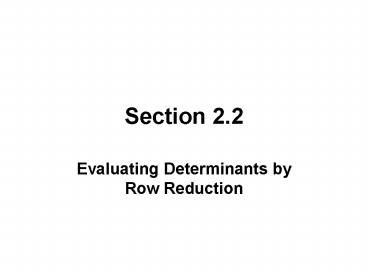Evaluating Determinants by Row Reduction - PowerPoint PPT Presentation
1 / 6
Title:
Evaluating Determinants by Row Reduction
Description:
Section 2.2 Evaluating Determinants by Row Reduction A THEOREM TRANSPOSES AND THE DETERMINANT ROW OPERATIONS AND DETERMINANTS ELEMENTARY MATRICES AND DETERMINANTS ... – PowerPoint PPT presentation
Number of Views:128
Avg rating:3.0/5.0
Title: Evaluating Determinants by Row Reduction
1
Section 2.2
- Evaluating Determinants by Row Reduction
2
A THEOREM
Theorem 2.2.1 Let A be a square matrix. If A
has a row or column of all zeros, then det(A)
0.
3
TRANSPOSES AND THE DETERMINANT
Theorem 2.2.2 Let A be a square matrix. Then
det(A) det(AT).
NOTE As a result of this theorem, nearly every
theorem about the determinants that contains the
word row in its statement is also true when the
word column is substituted for row.
4
ROW OPERATIONS AND DETERMINANTS
Theorem 2.2.3 Let A be and nn matrix. (a) If B
is the matrix that results when a single row or
single column of A is multiplied by any scalar k,
then det(B) k det(A). (b) If B is the matrix
that results when two rows or two columns of A
are interchanged, then det(B) -det(A). (c) If
B is the matrix that results when a multiple of
one row of A is added to another row or when a
multiple of one column is added to another
column, then det(B) det(A).
5
ELEMENTARY MATRICES AND DETERMINANTS
Theorem 2.2.4 Let E be an nn elementary
matrix. (a) If E results from multiplying a row
of In by k, then det(E) k. (b) If E results
from interchanging two rows of In, then det(E)
-1. (c) If E results from adding a multiple of
one row of In to another, then det(E) 1.
6
DETERMINANTS AND PROPORTIONAL ROWS/COLUMNS
Theorem 2.2.5 If A is a square matrix with two
proportional rows or two proportional columns,
then det(A) 0.

